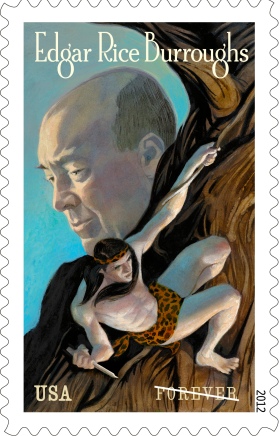So what does a postage stamp have to do with the successful landing of the Curiosity rover on Mars? According to one of the planet’s biggest Mars geeks, this incredible scientific achievement might not have been possible without the inspiration of recent stamp honoree Edgar Rice Burroughs.
Digital Color Postmark Keepsake (click image to order)
In a far-ranging interview, the late Ray Bradbury, author of The Martian Chronicles (1950), cited Burroughs as the writer who encouraged scientists to chase their Martian dreams.
“Edgar Rice Burroughs never would have looked upon himself as a social mover and shaker with social obligations,” Bradbury mused. “But as it turns out—and I love to say it because it upsets everyone terribly—Burroughs is probably the most influential writer in the entire history of the world.”
Bradbury enjoyed teasing snobs who cringed at the influence of science fiction, but he was making a serious point. Although Edgar Rice Burroughs wasn’t a scientist, his romantic visions of other planets sparked the dreams of generations of space explorers.
“I’ve talked to more biochemists and more astronomers and technologists in various fields, who, when they were ten years old, fell in love with John Carter and Tarzan and decided to become something romantic,” Bradbury said. “Burroughs put us on the moon. All the technologists read Burroughs. I was once at Caltech with a whole bunch of scientists and they all admitted it. Two leading astronomers—one from Cornell, the other from Caltech—came out and said, Yeah, that’s why we became astronomers. We wanted to see Mars more closely.”
Caltech, which manages the Jet Propulsion Laboratory for NASA, has already begun posting remarkable images from the surface of Mars, with many more to come. As we continue to “see Mars more closely,” remember what Burroughs bequeathed to us: a legacy of curiosity.
Tarzan™ Owned by Edgar Rice Burroughs, Inc. and Used by Permission.








